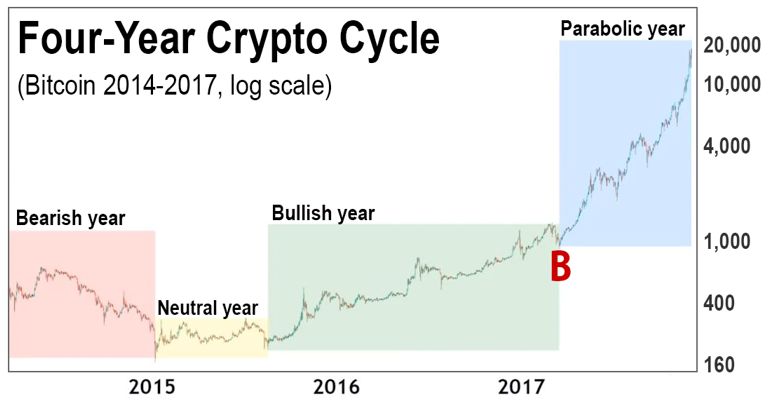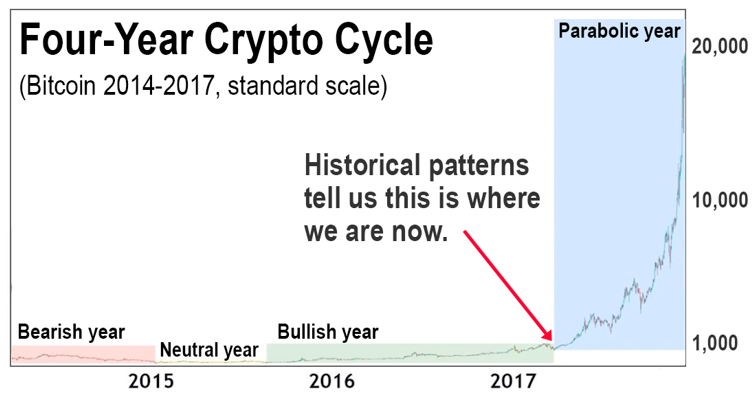The Real Meaning of Bitcoin’s Sharp Correction
 |
As usual, the Wall Street media has pounced on the latest decline in Bitcoin (BTC, Tech/Adoption Grade “A-”) to blame it on random events.
Some reporters say the decline was caused by a new push from Beijing to clamp down on Bitcoin.
But that’s an old story. In fact, four years ago, Bitcoin also took a big dip thanks to what was then called the “China ban.” Soon thereafter, the Kind of Crypto surged from $1,000 to nearly $20,000.
Others blame the dip on Elon Musk, who recently tweeted that Tesla, Inc. (Nasdaq: TSLA) would stop taking Bitcoin as a payment method. The last time something like this happened, Bitcoin also took a dip and then surged massively.
But weeks before any of the above news came out, our lead crypto expert, Juan Villaverde, warned of sharp correction in Bitcoin. And the reasons he cited have absolutely nothing to do with the news tidbits that the media points to after the fact.
Quite to the contrary, the latest price correction fits neatly with a recurring pattern that precedes the parabolic phase of every Bitcoin bull market in history.
The parabolic phase is when Bitcoin prices break all records, and investors have the opportunity to make the most money of all.
The last complete four-year Bitcoin cycle is typical:
 |
This chart of Bitcoin, from 2014-2017, uses condensed scales to more clearly show the price fluctuations. And as you can see, it depicts four one-year phases, in which …
Year one is BEARISH, the light red rectangle in the chart.
Year two is NEUTRAL,the yellow area.
Year three is BULLISH, the green area.
And year four is PARABOLIC, the blue section. This is when prices explode higher, as Bitcoin surges as much as 20-fold and other cryptocurrencies rise even more.
But here’s the key:
In the transition from the bullish year to the parabolic year, there is always a significant price correction, ending in a cyclical low (point B in the chart). And all our research tells us that’s precisely where we are today in the current cycle.
Historically, this correction is often sharp and scares away inexperienced Bitcoin investors. But subsequently, it paves the way for gains which are far larger than the gains that might have been possible in the “bullish” year of the four-year cycle.
To get a better sense of how big those gains can be, just take a look at the same chart, but this time using standard scaling:
 |
With this perspective, you can see, compared to the “parabolic year,” the big sums investors could have made in the “bullish year” seem tiny. Moreover, historical patterns tell us that …
Right now is that singular point in time which marks the onset of the parabolic phase in the crypto markets — a period that could be one of THE premier wealth-building events of our lifetime.
How can you make the best of it?
First of all, recognize that, although history helps guide our vision of the future, it cannot be foolproof. No one can predict the future with precision.
Second, I don’t have to tell you that crypto assets are risk assets. With the exception of stablecoins, which are typically pegged one-to-one to the U.S. dollar, extreme price volatility is a fact of life. But this year’s events have proven, once again, that the profit potential is greater than that of any other asset class.
Third, don’t be fooled by the now-defunct theory that blockchain technology has no substance or that Bitcoin is “rat poison squared.”
This technology is now performing practical functions which are in high demand all over the world.
For example, decentralized finance (DeFi) is already beginning to compete with a small but rapidly growing share of the global financial industry.
In fact, decentralized finance is a highly secure and efficient form of financial technology (Fintech).
Yes, it’s based on blockchain, the same basic tech pioneered by Bitcoin. But beyond that, it has very little to do with Bitcoin.
Here’s the key: This new financial technology makes it possible for virtually anyone — small investors, big institutions or even governments — to trade peer to peer.
In other words, it can replace many of the functions of third-party intermediaries, custodians and even regulators.
Currently, there are two widely used types of decentralized finance:
The first is what’s called “yield farming,” which could compete with traditional banking.
You stake (deposit) your money via an online platform. The system then searches for the optimal yield, which is invariably many times higher than today’s bank certificate of deposit (CDs).
And to virtually eliminate price risk, you can use U.S. dollar-pegged stablecoins.
The second type of decentralized finance is called a “decentralized exchange” (DEX).
A DEX aims to compete with established crypto exchanges, stock exchanges, futures exchanges and even foreign exchange markets.
You can already buy synthetic versions of cryptos, some shares and other assets. And in the near future, most widely traded stocks and commodities should also be available.
How big is the DeFi industry overall? You can track it at DeFi Pulse.
It has taken a big dip in the last couple of weeks due to the sharp correction in crypto asset values.
But the growth overall has been extremely impressive — from less than $1 billion one year ago in Total Value Locked (TVL), roughly the equivalent of “assets on deposit,” to a peak of $88 billion on May 11, or about 90 times greater.
But even $88 billion is still tiny to the total assets of the global financial industry, which are more than $400 trillion.
So, if DeFi replaces just 1% of that in the future, it will have grown to $4 trillion.
Good luck and God bless!
Martin

